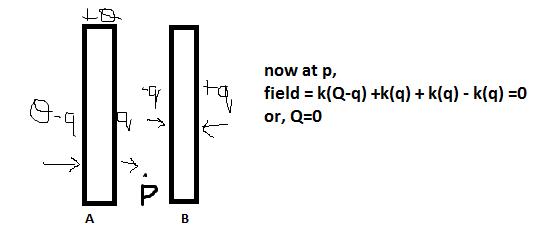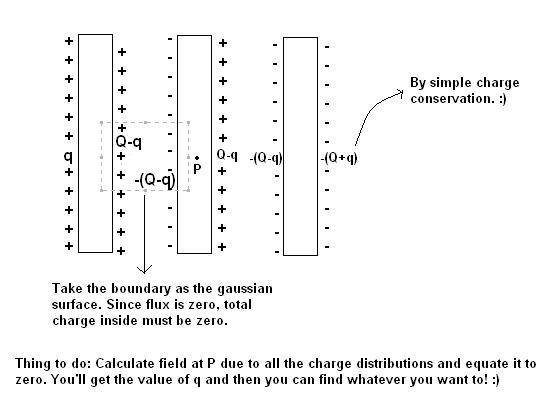in @ashish's diagram lets mark the surfaces as 1,2,3,4 ..now my doubt is that how do we say/assume the field due to which surface is in which direction?!!!
plz can someone explain me how the charges are distributed in conductors placed side by side .
i know i am going wrong somewhere but yet not able to understand .
sample question
3 conductors- A B C
+Q 0 -2Q
Find final charge distribution.
-
UP 0 DOWN 0 0 23

23 Answers
u seem not to appreciate the mess u just made in your copy after solving a problem! [3]
I used to appreciate those things like hand writing, the diagrams etc for at least 1 minute after the sum was solved!
This revealed many of the hidden secrets like this to me! :P
Try appreciating the mess you created after each battle! You wud suddenly become a pro in the topic! :D
The good thing is that you need not worry whether it is positive or negative. Just assume postive/negative and stick to it till the end. Your answer will carry a negative sign if you assumed something wrong. Just make sure to report the answer after correcting that incorrect assumption . [1]
i don't get how can we say that at 'p' the field due to which plate is in which direction...
as we are not given the magnitudes...how do we know that Q - q is positive or negative...??
Thats what he meant. Sometimes its just all about appreciating the "mess" of our handwriting. :D
@Appreciating the mess :
" Whenever I appreciate my hand writing and all, I began to loose everything out of my mind.. Even my handwriting becomes unreadable to me "
How to tackle this.. Now I don't have time to improve my hand writing either!! :)
Why get into competition? :P
Appreciate all the mess u made after u made it! ;)
Bhaiya I do this but then the thought that comes to my mind (and it always does!) "okay nothing to get so inflated. You're not the only one who did it!" And then I move on. But I can tell you I do come back at times and look with pleasure at THE MESS!
once it went till 2 hours! :P
I had attempted that sum for 3 days! [3]
@subhomoy da:
:P ''I used to appreciate those things like hand writing, the diagrams etc for at least 1 minute after the sum was solved!''
i also do, sometimes 5-10 mins :P
http://www.targetiit.com/iit-jee-forum/posts/capacitor-19509.html
Wow. This seems to be a nice generalisation. Never thought of it! [1]
1/2(sum total of charge in the system) lies in the outer surface of the external plates(ie: A & C)
this is the result of the fact that field inside a conductor is necessarily 0 in conditions of electrostatics! [1]
thnx guys.... thats why i wasnt able to solve even a question from h.c.verma
Where does this come from "1/2(sum total of charge in the system) lies in the outer surface of the external plates(ie: A & C)"?
For check : 1/2(sum total of charge in the system) lies in the outer surface of the external plates(ie: A & C).And the inner one behaves as a parallel plate capacitor(ie: +q &-q).And total charge in any plate is constant. so the ans must be(-Q/2,3Q/2 ;-3Q/2,+3Q/2 ;-3Q/2,-Q/2)
You're making a mistake. The field at the point P in your diagram is not zero. Take a point inside any of the two conducting plates and find the field there. Over there, the field can be equated to zero. Like in the above example, lets take a point Q inside the first plate having charge +Q.
Net field (+ve towards right) = k(Q-q) - Kq - Kq + Kq
hence,
Q - q - q = 0
Giving, q = Q2
i have already done these steps but i am going wrong somewhere while finding field at p and equating to zero. plz help me in that portion
for eg. lets take a small question-
A B
+Q 0
find the final charge distribution

i have checked h.c.verma but can not understand the soln. they have also taken the siqn of the charge while finding the field
